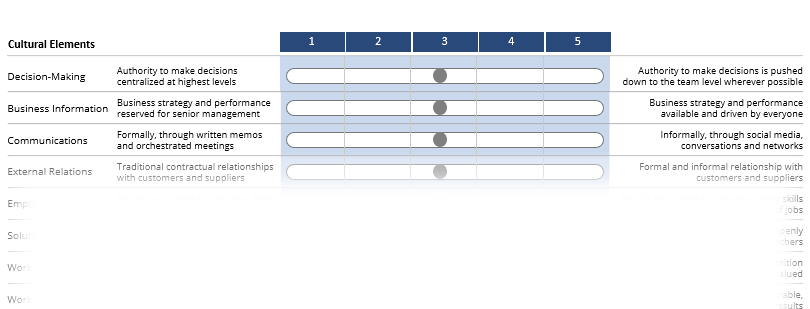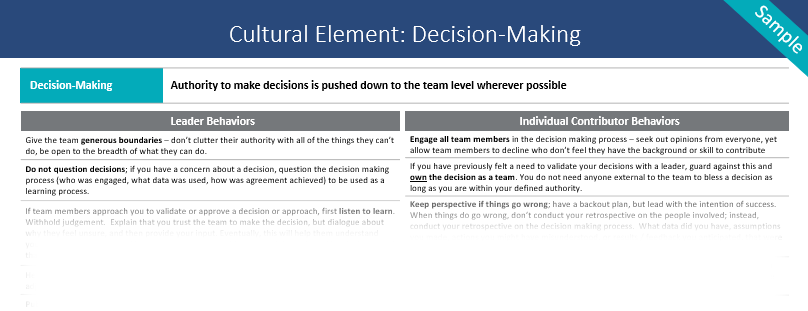Your business is likely in the midst of a major digital transformation. If not digital, then your IT organization is likely working to increase enterprise agility by adopting DevOps and Agile methodologies. Many organizations today are attempting both at once. If you identify with any of these scenarios, you are likely discovering that managing cultural change is the single most significant factor to your success. Culture change is hard to define, hard to measure and, therefore, hard to do.
What exactly is culture? It is the sum of attitudes, customs and beliefs that distinguishes one group of people from another. Corporate or organizational culture refers to the shared values, attitudes, standards and beliefs that characterize members of an organization, defining how it works, how it makes decisions and how it presents itself to the market.
Organizational cultures are exhibited through the common behaviors of people inside the organization – executives and employees alike. These behaviors are what demonstrate the attitudes, customs and beliefs of the people who comprise the organization. When we talk about creating cultural change, what we are really talking about is changing behaviors – the behaviors of leaders as well as employees at every organizational level. As an organization encourages, recognizes, rewards and supports new behaviors, new actions and reactions, it will begin to see those behaviors become the accepted norms, customs and habits of a new culture.
How Do We Define the Culture We Want?
First, we must determine the behavioral-influenced elements of culture – how we make decisions, how we collaborate, how we reward, etc. – and we must determine the situations in which we would like to see different values, attitudes, standards and beliefs – all of which are observable through behaviors. Figure 1 below is a snapshot of some of the cultural elements we often address as we help organizations transform to an agile enterprise.

Figure 1: Cultural Elements
Let’s look at the cultural element of decision-making. Are decisions hierarchical in your organization? Is there an unwritten code that, while process authority might give you the right to make a decision to purchase supplies, the norm is to run it by your boss first? If you’re trying to empower teams, you likely want certain decisions to be made at the lowest level possible without the need to run it by the boss. You can talk about non-hierarchical decision-making, but without addressing current standards of behavior, you fail to address the underlying culture that reinforces those behaviors – and you may seriously impede your ability to empower teams.
A key to creating lasting cultural change is defining the to-be state of behaviors you want to see demonstrated across various components of the culture. If we define the behaviors we expect within each of these components – from leaders, managers and throughout the company – we’ve at least set a level of expectation within the organization and defined what the new culture “looks like” by exemplifying the appropriate behaviors.
In the end, people need to understand three things a cultural transformation: 1) What does the organization want me to stop doing? 2) What does the organization want me to start doing? and 3) What does the organization want me to continue doing? Without these three questions answered, it is difficult for people in the organization to adopt a new operating structure.
The snapshot below defines some behaviors we recommend for the cultural change element of decision-making:

Figure 2: Behaviors for Decision-Making
Measuring Behavioral Change
While we may have good role models acting out the behaviors we believe will enable a new culture, measuring behaviors is difficult. Since behaviors are how we act and react within a given situation, measurement requires observation of that situation. But not everyone has the opportunity to observe the behavior because they may not find themselves in a situation to do so. So how do we measure culture change if the main predictor of culture is behavior, and behavior has to be observed situationally?
The answer is to cast a wide net and ask for subjective perspectives from members of the organization at large as to whether they see the culture you are trying to engender. In other words, if you have ten cultural elements you want to change, you need to measure by observation across them with a great-enough number of people and a large-enough number of behavioral examples, so you have a statistically relevant number of responses.
Measure these observations on a differentiated scale rather than a linear one, where one side of the scale exemplifies the culture you would like to see diminish, and the other side exemplifies the culture you are trying to promote. Give behavioral examples for each cultural element, so the cultural element is recognizable to people as they consider their day-to-day tasks and interactions. This has the added benefit of providing a communication vehicle for staff to recognize appropriate behaviors in themselves as well; so not only are you measuring, you’re also driving subtle change management at the same time.
Encouraging New Habits that Reinforce Culture Change
Describing desired behaviors and measuring their result is imperative, but the established norms are habits that are hard to break. How do you encourage people to break them? The following are some lessons learned from our work with culture change:
- Describe where you’re going and why. Communicating the underlying reason and/or context can help your organization recognize the logic for expending the effort to change.
- Describe the results and the value of the behavior you’re expecting. Then help people recognize the new behavior.
- Publicly recognize appropriate behaviors and quietly coach the wrong behaviors.
- Be sure your incentives, rewards and performance objectives align with the culture you’re prescribing.
- Offer situational practice sessions that allow participants to see what good looks like, practice behaviors in a safe environment, and hear a coach explain and contextualize appropriate actions and reactions.
Breaking a habit takes time and practice and often requires a new habit to take its place. That’s culture change in its simplest form. Enterprise culture change requires changing many habits across an entire organization at the same time. Don’t underestimate the challenges of such change. While people, process and technology comprise the levers you may pull to promote change, remember the people part of your transformation is the most important for sustaining change.
ISG uses a proven culture change methodology to help enterprises on their transformation journey. Contact us to find out how we can help your organization enable the behaviors necessary to transform to an agile enterprise.
